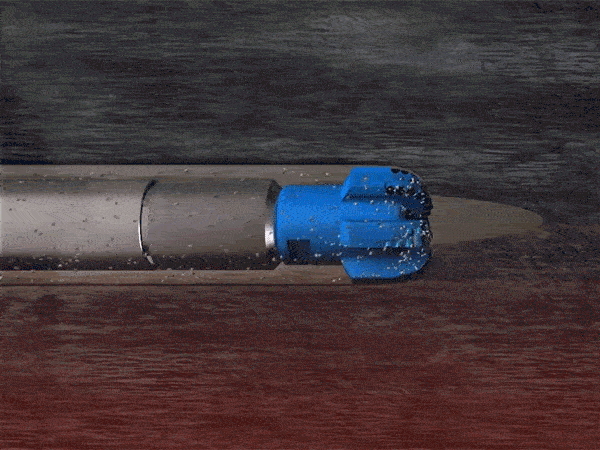Is Google Going Underground With Hypersonic Tech?
High-speed drilling and tunneling machines could revolutionize geothermal energy and enable Hyperloop trains
Google is carrying out research on hypersonics, probably for new technologies to slash the cost of geothermal energy and tunneling. It could also be acquiring a Washington-based startup called HyperSciences that has already built prototype devices.
In January, Google signed a US $100,000 Space Act Agreement with NASA’s Ames Research Center in Silicon Valley. The agreement says “Google’s research division is doing a conceptual exploration of hypersonic trajectories in high Reynolds number ablation regimes,” and calls for NASA to “perform an analysis of a hypersonic projectile traveling through dense atmosphere.”
Hypersonics refers to anything travelling five times the speed of sound or faster, and usually refers to extremely high speed aircraft or weapons, such as Boeing’s unmanned X51 scramjet or the new Russian ballistic missile that Vladimir Putin boasted about last week.
However, according to his LinkedIn profile, the Seattle-based Google researcher working on the project is focused on climate and energy R&D rather than aerospace.
There is one U.S. company working on a renewable energy system using hypersonics: a startup called HyperSciences that was spun out of the University of Washington, also in Seattle. HyperSciences is developing a novel drilling system that fires concrete projectiles at over 2 kilometers per second in advance of a drill bit. It claims that its system can drill deep wells up to 10 times faster than existing systems, enabling geothermal energy “anywhere in the world.”
When contacted by IEEE Spectrum last week, HyperSciences founder and CEO Mark Russell said, “We have been spending some time with [Google].” He said he would be able to share more about his company’s plans, at the South by Southwest festival in Austin this week.
Since it was founded in 2015, HyperSciences has raised more than $2.8 million in early stage investments and received at least $1 million from Shell’s GameChanger incubator. It currently has a $1.9 million Series A funding round open.
Google’s parent company Alphabet has long had an interest in geothermal energy. Last July, its moonshot X division launched a company called Dandelion that is already selling domestic geothermal systems to homes in New York state. Dandelion’s systems send water about 150 meters down plastic pipes to reach stable temperatures of 10 degrees C (50 degress F) underground. A heat pump above then uses that water to efficiently warm the house in winter or cool it during the summer.
The technology being developed by HyperSciences should make it cheaper to reach much higher temperatures even deeper down, up to 7 kilometers below the surface. Every few seconds, a concrete projectile is boosted down the drill shaft at over Mach 5 by a combustible mixture of air and diesel gases. The projectile then vaporizes cleanly at the rock face, breaking it up.
Once the well is complete, pipes containing silicone oil rather than water would transfer heat to the surface, where thermoelectric generators would convert it directly into electricity. HyperSciences says such a system will be more efficient than solar panels or wind turbines, and cheaper than conventional carbon-based power stations.
HyperSciences is also developing a tunneling system using the same hypersonic projectile technology. It claims that its so-called Hyper Tunnel Boring and Mining System will be five times cheaper than today’s tunnel boring machines, and be able to dig tunnels two and a half times faster.
Acquiring HyperSciences would pit Google head to head with Elon Musk. His The Boring Company is trying to dramatically improve the cost and speed of tunnel boring, in order to build tunnels for Hyperloop trains and subterranean networks of car-carrying electric sleds.
Google’s agreement with NASA called for the agency to use a database it had developed for the reentry of spacecraft into the Earth’s atmosphere, to simulate the path of variously shaped hypersonic projectiles. NASA would also assess possible thermal protection systems, presumably for the rest of the drilling system.
NASA’s work on the Google project might already be over. The entire process was due to have taken as little as seven weeks, and would have cost Google $99,489.
Of course, Google’s hypersonic research may have nothing to do with HyperSciences. Google would not comment on any potential business relationships but noted that its researchers frequently collaborate with outside researchers and companies, without that leading to an investment or acquisition.
After publication, HyperSciences told IEEE Spectrum that it was not currently talking with Google about a deal.
Editor's note: This story was updated on 5 March.
Mark Harris is an investigative science and technology reporter based in Seattle, with a particular interest in robotics, transportation, green technologies, and medical devices. He’s on Twitter at @meharris and email at mark(at)meharris(dot)com. Email or DM for Signal number for sensitive/encrypted messaging.
